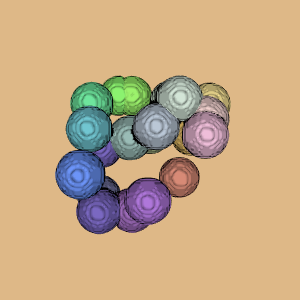SmoothDiscreteFlyingEdges3D
web-test/PythonicAPI/Modelling/SmoothDiscreteFlyingEdges3D
Description¶
Creates surfaces from labeled data. Volume data does not always contain samples of continuous data. A volume may contain discrete integer values, often the result of segmentation. This example smooths the discrete models generated by vtkDiscreteFlyingEdges3D with vtkWindowedSincPolyDataFilter.
An option is provided to use vtkDiscreteMarchingCubes instead of vtkDiscreteFlyingEdges3D.
Seealso
DiscreteFlyingEdges3D produces rough models.
Question
If you have a question about this example, please use the VTK Discourse Forum
Code¶
SmoothDiscreteFlyingEdges3D.py
#!/usr/bin/env python3
from dataclasses import dataclass
# noinspection PyUnresolvedReferences
import vtkmodules.vtkInteractionStyle
# noinspection PyUnresolvedReferences
import vtkmodules.vtkRenderingOpenGL2
from vtkmodules.vtkCommonColor import vtkNamedColors
from vtkmodules.vtkCommonCore import (
vtkLookupTable,
vtkMinimalStandardRandomSequence
)
from vtkmodules.vtkCommonDataModel import (
vtkImageData,
vtkSphere
)
from vtkmodules.vtkFiltersCore import vtkWindowedSincPolyDataFilter
from vtkmodules.vtkFiltersGeneral import (
vtkDiscreteFlyingEdges3D,
vtkDiscreteMarchingCubes
)
from vtkmodules.vtkImagingCore import vtkImageThreshold
from vtkmodules.vtkImagingHybrid import vtkSampleFunction
from vtkmodules.vtkImagingMath import vtkImageMathematics
from vtkmodules.vtkRenderingCore import (
vtkActor,
vtkPolyDataMapper,
vtkRenderWindow,
vtkRenderWindowInteractor,
vtkRenderer
)
def get_program_parameters():
import argparse
description = 'Create surfaces from labeled data and smooth them.'
epilogue = '''
'''
parser = argparse.ArgumentParser(description=description, epilog=epilogue,
formatter_class=argparse.RawDescriptionHelpFormatter)
parser.add_argument('-m', '--marching_cubes', action='store_false',
help='Use Marching Cubes instead of Flying Edges.')
args = parser.parse_args()
return args.marching_cubes
def main():
use_flying_edges = get_program_parameters()
colors = vtkNamedColors()
# Create the RenderWindow, Renderer, Interactor
ren = vtkRenderer(background=colors.GetColor3d('Burlywood'))
ren_win = vtkRenderWindow(window_name='SmoothDiscreteMarchingCubes')
ren_win.AddRenderer(ren)
iren = vtkRenderWindowInteractor()
iren.SetRenderWindow(ren_win)
n = 20
radius = 8
blob = make_blob(n, radius)
if use_flying_edges:
discrete = vtkDiscreteFlyingEdges3D()
else:
discrete = vtkDiscreteMarchingCubes()
discrete.GenerateValues(n, 1, n)
smoothing_iterations = 15
pass_band = 0.001
feature_angle = 120.0
smoother = vtkWindowedSincPolyDataFilter(number_of_iterations=smoothing_iterations,
pass_band=pass_band, feature_angle=feature_angle,
boundary_smoothing=False,
feature_edge_smoothing=False,
non_manifold_smoothing=True,
normalize_coordinates=True)
lut = make_colors(n)
mapper = vtkPolyDataMapper(lookup_table=lut, scalar_range=(0, lut.number_of_colors))
blob >> discrete >> smoother >> mapper
actor = vtkActor(mapper=mapper)
ren.AddActor(actor)
ren_win.Render()
iren.Start()
def make_blob(n, radius):
blob_image = vtkImageData()
max_r = 50 - 2.0 * radius
random_sequence = vtkMinimalStandardRandomSequence(seed=5071)
for i in range(0, n):
x = random_sequence.GetRangeValue(-max_r, max_r)
random_sequence.Next()
y = random_sequence.GetRangeValue(-max_r, max_r)
random_sequence.Next()
z = random_sequence.GetRangeValue(-max_r, max_r)
random_sequence.Next()
sphere = vtkSphere(radius=radius, center=(int(x), int(y), int(z)))
sampler = vtkSampleFunction(implicit_function=sphere, output_scalar_type=ImageCast.OutputScalarType.VTK_FLOAT,
sample_dimensions=(100, 100, 100), model_bounds=(-50, 50, -50, 50, -50, 50))
thres = vtkImageThreshold(replace_in=True, replace_out=True, in_value=i + 1, out_value=0)
thres.ThresholdByLower(radius * radius)
(sampler >> thres).update()
if i == 0:
blob_image.DeepCopy(thres.output)
max_value = vtkImageMathematics(operation=ImageMathematics.Operation.VTK_MAX)
((blob_image, thres) >> max_value).update()
blob_image.DeepCopy(max_value.output)
return blob_image
def make_colors(n):
"""
Generate some random colors
:param n: The number of colors.
:return: The lookup table.
"""
lut = vtkLookupTable(number_of_colors=n, table_range=(0, n - 1), scale=LookupTable.Scale.VTK_SCALE_LINEAR)
lut.Build()
lut.table_value = (0, 0.0, 0.0, 0.0, 1.0)
random_sequence = vtkMinimalStandardRandomSequence()
random_sequence.SetSeed(5071)
for i in range(1, n):
r = random_sequence.GetRangeValue(0.4, 1)
random_sequence.Next()
g = random_sequence.GetRangeValue(0.4, 1)
random_sequence.Next()
b = random_sequence.GetRangeValue(0.4, 1)
random_sequence.Next()
lut.table_value = (i, r, g, b, 1.0)
return lut
@dataclass(frozen=True)
class ImageCast:
@dataclass(frozen=True)
class OutputScalarType:
VTK_CHAR: int = 2
VTK_UNSIGNED_CHAR: int = 3
VTK_SHORT: int = 4
VTK_UNSIGNED_SHORT: int = 5
VTK_INT: int = 6
VTK_UNSIGNED_INT: int = 7
VTK_LONG: int = 8
VTK_UNSIGNED_LONG: int = 9
VTK_FLOAT: int = 10
VTK_DOUBLE: int = 11
@dataclass(frozen=True)
class ImageMathematics:
@dataclass(frozen=True)
class Operation:
VTK_ADD: int = 0
VTK_SUBTRACT: int = 1
VTK_MULTIPLY: int = 2
VTK_DIVIDE: int = 3
VTK_INVERT: int = 4
VTK_SIN: int = 5
VTK_COS: int = 6
VTK_EXP: int = 7
VTK_LOG: int = 8
VTK_ABS: int = 9
VTK_SQR: int = 10
VTK_SQRT: int = 11
VTK_MIN: int = 12
VTK_MAX: int = 13
VTK_ATAN: int = 14
VTK_ATAN2: int = 15
VTK_MULTIPLYBYK: int = 16
VTK_ADDC: int = 17
VTK_CONJUGATE: int = 18
VTK_COMPLEX_MULTIPLY: int = 19
VTK_REPLACECBYK: int = 20
@dataclass(frozen=True)
class LookupTable:
@dataclass(frozen=True)
class Scale:
VTK_SCALE_LINEAR: int = 0
VTK_SCALE_LOG10: int = 1
if __name__ == '__main__':
main()
